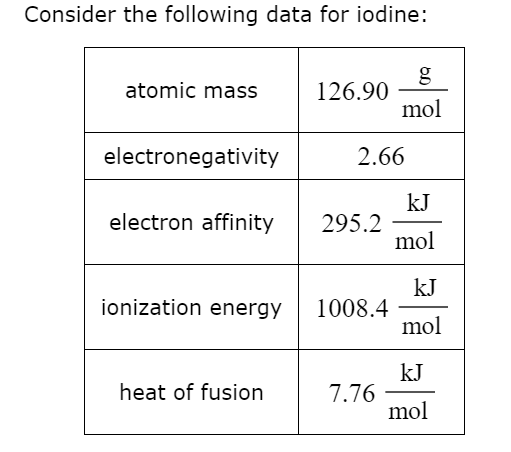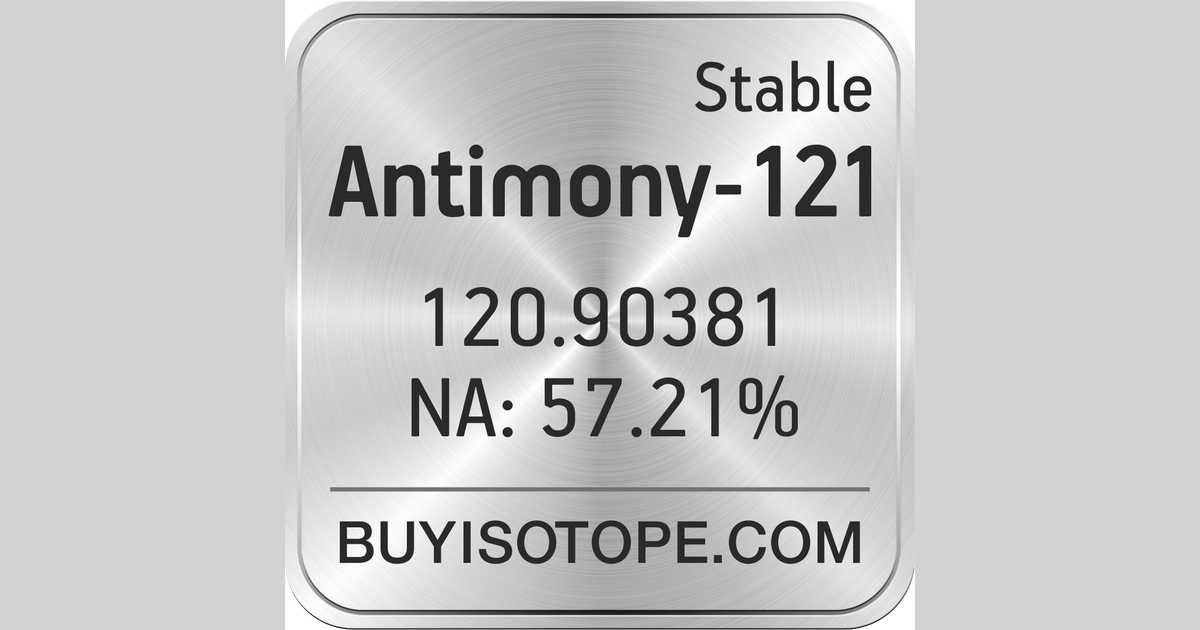Element Iodine - I
››More information on molar mass and molecular weight. In chemistry, the formula weight is a quantity computed by multiplying the atomic weight (in atomic mass units) of each element in a chemical formula by the number of atoms of that element present in the formula, then adding all of these products together. Atomic Mass # of Atoms: Mass Percent: Sodium: Na: 22.989770: 1: 15.337%: Iodine: I: 126.90447: 1: 84.663% ››. Iodine in pure form is an almost black crystalline solid with a slightly metallic lustre. Warmed gently, it gives off a dense, beautiful blue-violet vapor of diatomic iodine. It exhibits a similar blue-violet color in solution in chloroform, carbon tetrachloride, and carbon disulfide, suggesting that it molecular form is maintained in such. Iodine (I) Atomic Data for Iodine (I) Atomic Number = 53 Atomic Weight = 126.90447 Reference E95: Isotope: Mass: Abundance: Spin: Mag Moment: 127 I: 126.904473.
Iodine I-131 is a radioactive isotope of iodine with an atomic mass of 131, a half life of eight days, and potential antineoplastic activity. Selectively accumulating in the thyroid gland, iodine I 131 emits beta and gamma particles, thereby killing thyroid.


Comprehensive data on the chemical element Iodine is provided on this page; including scores of properties, element names in many languages, most known nuclides of Iodine. Common chemical compounds are also provided for many elements. In addition technical terms are linked to their definitions and the menu contains links to related articles that are a great aid in one's studies.
Iodine Menu
- Iodine Page One
- Iodine Page Two
- Iodine Page Three
Overview of Iodine
- Atomic Number: 53
- Group: 17
- Period: 5
- Series: Halogens
Iodine's Name in Other Languages
- Latin: Iodum
- Czech: Jod
- Croatian: Jod
- French: Iode
- German: Jod - r
- Italian: Iodio
- Norwegian: Jod
- Portuguese: Iôdo
- Russian: Иод
- Spanish: Yodo
- Swedish: Jod
Atomic Weight Calculator

Atomic Structure of Iodine
- Atomic Radius: 1.32Å
- Atomic Volume: 25.74cm3/mol
- Covalent Radius: 1.33Å
- Cross Section (Thermal Neutron Capture) σa/barns: 6.2
- Crystal Structure: Orthorhombic
- Electron Configuration:
- 1s2 2s2p6 3s2p6d10 4s2p6d10 5s2p5
- Electrons per Energy Level: 2,8,18,18,7
- Shell Model
- Shell Model
- Ionic Radius: 2.2Å
- Filling Orbital: 5p5
- Number of Electrons (with no charge): 53
- Number of Neutrons (most common/stable nuclide): 74
- Number of Protons: 53
- Oxidation States:±1,5,7
- Valence Electrons: 5s2p5
- Electron Dot Model
- Electron Dot Model
Chemical Properties of Iodine
- Electrochemical Equivalent: 4.7348g/amp-hr
- Electron Work Function:
- Electronegativity: 2.66 (Pauling); 2.21 (Allrod Rochow)
- Heat of Fusion: 7.824kJ/mol
- Incompatibilities:
- Ammonia, acetylene, acetaldehyde, powdered aluminum, active metals, liquid chlorine
- Ionization Potential
- First: 10.451
- Second: 19.131
- Third: 33
- Valence Electron Potential (-eV): -6.55
Physical Properties of Iodine
- Atomic Mass Average: 126.9045
- Boiling Point: 458.55K 185.4°C 365.7°F
- Coefficient of lineal thermal expansion/K-1: N/A
- Conductivity
- Electrical: 8.0E-16 106/cm Ω
Thermal: 0.00449 W/cmk
- Electrical: 8.0E-16 106/cm Ω
- Density: 4.93g/cc @ 300K
- Description:
- Halogen solid form: shiny, non-metallic, grayish-black flakes; gas: violet.
- Elastic Modulus:
- Bulk: 7.7/GPa
- Enthalpy of Atomization: 106.7 kJ/mole @ 25°C
- Enthalpy of Fusion: 7.76 kJ/mole
- Enthalpy of Vaporization: 20.88 kJ/mole
- Flammablity Class: Non-combustible solid
- Freezing Point:see melting point
- Heat of Vaporization: 20.752kJ/mol
- Melting Point: 386.65K 113.5°C 236.3°F
- Molar Volume: 25.74 cm3/mole
- Physical State (at 20°C & 1atm): Solid
- Specific Heat: 0.214J/gK
Regulatory / Health
- CAS Number
- 7553-56-2
- RTECS: NN1575000
- OSHAPermissible Exposure Limit (PEL)
- 1 ppm = 10.38mg/m3 @ 25°C & 1 atm
- Ceiling: 0.1 ppm
- OSHA PEL Vacated 1989
- Ceiling: 0.1 ppm
- NIOSHRecommended Exposure Limit (REL)
- Ceiling: 0.1 ppm
- IDLH: 2 ppm
- Routes of Exposure: Inhalation; Ingestion; Skin and/or eye contact
- Target Organs: Eyes, skin, respiratory system, central nervous system, cardiovascular system
- Levels In Humans:
Note: this data represents naturally occuring levels of elements in the typical human, it DOES NOT represent recommended daily allowances.- Blood/mg dm-3: 0.057
- Bone/p.p.m: 0.27
- Liver/p.p.m: 0.7
- Muscle/p.p.m: 0.05-0.5
- Daily Dietary Intake: 0.1-0.2 mg
- Total Mass In Avg. 70kg human: 12-20 mg
Who / Where / When / How
- Discoverer: Bernard Courtois
- Discovery Location: Dijon France
- Discovery Year: 1811
- Name Origin:
- Greek: iôdes (violet).
- Abundance of Iodine:
- Earth's Crust/p.p.m.: 0.14
- Seawater/p.p.m.:
- Atlantic Suface: 0.0489
- Atlantic Deep: 0.056
- Pacific Surface: 0.043
- Pacific Deep: 0.058
- Atmosphere/p.p.m.: N/A
- Sun (Relative to H=1E12): N/A
- Sources of Iodine:
- Occurs on land and in the sea in sodium and potassium compounds. World production of iodine is around 12,000 tons. Primary producing areas are Chile and Japan.
- Uses of Iodine:
- Required in small amounts by humans. Once used as an antiseptic, but no longer due to its poisonous nature. Used as a disinfectant, in pharmaceuticals, dyes, catalysts and photography.
- Additional Notes:
Iodine Atomic Mass In Kg
Iodine Menu
- Iodine Page One
- Iodine Page Two
- Iodine Page Three
Iodine Atomic Mass
References

A list of reference sources used to compile the data provided on our periodic table of elements can be found on the main periodic table page.
Related Resources
Iodine Atomic Mass Rounded
- Anatomy of the Atom
Answers many questions regarding the structure of atoms. - Molarity, Molality and Normality
Introduces stoichiometry and explains the differences between molarity, molality and normality. - Molar Mass Calculations and Javascript Calculator
Molar mass calculations are explained and there is a JavaScript calculator to aid calculations. - Chemical Database
This database focuses on the most common chemical compounds used in the home and industry.
Citing this page
.svg/1200px-CIAAW_2013_-_Standard_atomic_weight_for_cupper_(29%2C_Cu).svg.png)
If you need to cite this page, you can copy this text:
Kenneth Barbalace. Periodic Table of Elements - Iodine - I. EnvironmentalChemistry.com. 1995 - 2021. Accessed on-line: 4/24/2021
https://EnvironmentalChemistry.com/yogi/periodic/I.html
.
Linking to this page
If you would like to link to this page from your website, blog, etc., copy and paste this link code (in red) and modify it to suit your needs:
Protons In Iodine
<a href='https://EnvironmentalChemistry.com/yogi/periodic/I.html'>echo Periodic Table of Elements: Iodine - I (EnvironmentalChemistry.com)</a>- Comprehensive information for the element Iodine - I is provided by this page including scores of properties, element names in many languages, most known nuclides and technical terms are linked to their definitions.
.
NOTICE: While linking to articles is encouraged, OUR ARTICLES MAY NOT BE COPIED TO OR REPUBLISHED ON ANOTHER WEBSITE UNDER ANY CIRCUMSTANCES.
Iodine Atomic Mass Wikipedia
PLEASE, if you like an article we published simply link to it on our website do not republish it.
